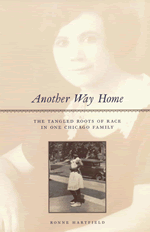Another Way Home: The Tangled Roots of Race in One Chicago FamilyPosted in Autobiography, Biography, Books, History, Identity Development/Psychology, Media Archive, Monographs, United States on 2010-07-05 05:10Z by Steven |
Another Way Home: The Tangled Roots of Race in One Chicago Family
University of Chicago Press
2004
200 pages
22 halftones, 5-1/2 x 8-1/2
Cloth ISBN: 9780226318219
Paper ISBN: 9780226318233
Ronne Hartfield
In her prologue to Another Way Home, Ronne Hartfield notes the dearth of stories about African Americans who have occupied the area of mixed race with ease and harmony for generations. Her moving family history is filled with such stories, told in beautifully crafted and unsentimental prose. Spanning most of the twentieth century, Hartfield’s book celebrates the special occasion of being born and reared in a household where miscegenation was the rule rather than the exception—where being a woman of mixed race could be a fundamental source of strength, vitality, and courage.
Hartfield begins with the early life of her mother, Day Shepherd. Born to a wealthy British plantation owner and the mixed-race daughter of a former slave, Day negotiates the complicated circumstances of plantation life in the border country of Louisiana and Mississippi and, as she enters womanhood, the quadroon and octoroon societies of New Orleans. Equally a tale of the Great Migration, Another Way Home traces Day’s journey to Bronzeville, the epicenter of black Chicago during the first half of the twentieth century. Here, through the eyes of Day and, ultimately, her daughter, we witness the bustling city streets and vibrant middle-class culture of this iconic black neighborhood. We also relive crucial moments in African American history as they are experienced by the author’s family and others in Chicago’s South Side black community, from the race riots of 1919 and the Great Depression to the murder of Emmett Till and the dawn of the civil rights movement.
Throughout her book, Hartfield portrays mixed-race Americans navigating the challenges of their lives with resilience and grace, making Another Way Home an intimate and compelling encounter with one family’s response to our racially charged culture.
Read an excerpt here.
Table of Contents
Prologue
1. Alpha: The Long Mysterious Exodus of Death
2. Beginnings: Strange Fates
3. Sacred Wounds
4. On the Place
5. Matriarchy
6. The Lightning Fields
7. New Orleans
8. Day and the City
9. The Ring
10. A Stern Destiny: Chicago Found and Lost
11. The Post-Depression Years
12. Streetcars
13. In the Castle of Our Skin
14. Dining In
15. Go Down the Street
16. Naming the Holy
17. Strange Fruit
18. Our Father’s Freight Train Blues
19. Lifelines
20. Last Years
21. Omega
Epilogue
Acknowledgments

